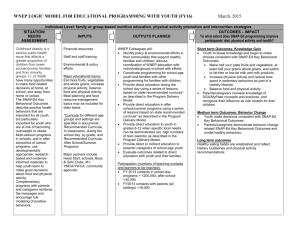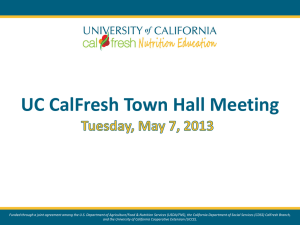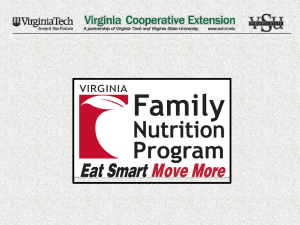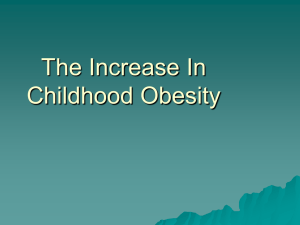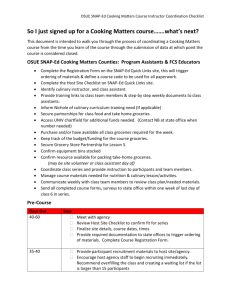Implementing SNAP-Ed 2.0 - University of Missouri Extension
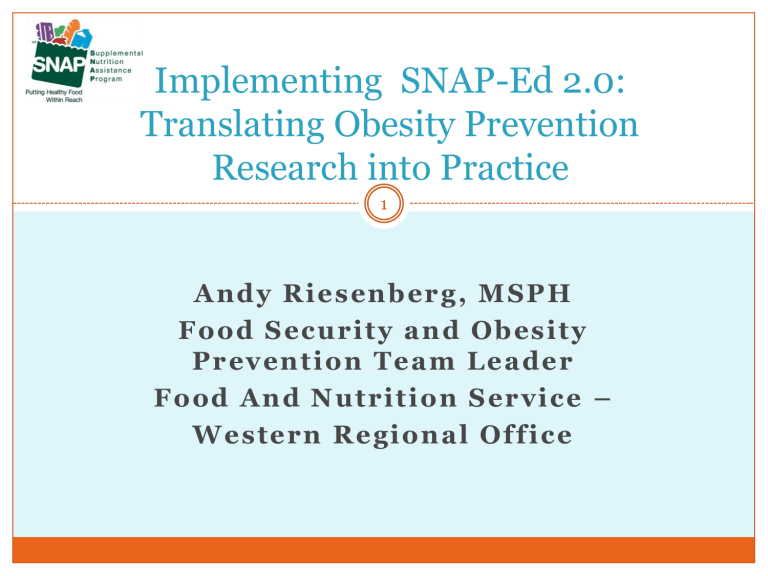
Implementing SNAP-Ed 2.0:
Translating Obesity Prevention
Research into Practice
1
Andy Riesenberg, MSPH
Food Security and Obesity
Prevention Team Leader
Food And Nutrition Service –
Western Regional Office
3.
4.
1.
2.
Purpose
2
SNAP-Ed 2.0.
Evidence-based programs for nutrition education and obesity prevention.
Regional examples.
Evaluation outcomes.
SNAP-Ed 2.0
3
Educational strategies, accompanied by environmental supports, designed to facilitate voluntary adoption of food and physical activity choices and other nutrition-related behaviors among the SNAP-Ed target audience.
Improve nutrition
Increase physical activity
Maintain appropriate calorie balance during each stage of life
Key Elements
4
Requires the implementation and evaluation of comprehensive evidence-based activities for nutrition education and obesity prevention;
Allows for gardening and physical activity interventions combined with nutrition education;
Offers greater flexibility in targeting the SNAP population and potentially eligibles.
Evidence-Based Programs
5
Requires the use of evidence-based activities:
Tier 1: The strategy is based upon relevant rigorous nutrition and public health nutrition research including systematically reviewed scientific evidence.
Tier 2: The strategy is based upon case studies, pilot studies, and evidence from the field on nutrition education interventions that demonstrate obesity prevention potential.
Childhood Obesity Prevention
Programs: Comparative Effectiveness
6
School-Based
Interventions
Home
Component
Community
Component
Highest Evidence in Preventing
Childhood Obesity or Overweight
Source: Childhood Obesity Prevention Programs: Comparative Effectiveness Review and Meta-Analysis, June 2013.
Available at www.effectivehealthcare.ahrq.gov/child-obesity-prevention.cfm.
7
Discussion Question
8
What is the difference between evidence-based practice and practice-based evidence? Why are both important?
Socio-Ecological Model
9
Source: Institute of Medicine 10
Ten Essential Public Health Services
11
Monitor health status.
Diagnose and investigate health problems and health hazards..
Inform, educate, and empower people about health issues.
Mobilize community partnerships.
Develop policies and plans.
Enforce laws and regulations that protect health and ensure safety.
Link people to needed personal health services.
Assure a competent public health workforce.
Evaluate effectiveness, accessibility, and quality of services.
Research for new insights and innovative solutions to health problems.
Implementing Environmental Approach
12
• Problem Identification
• Measuring:
• Availability
• Access
• Usage
• Appeal
Conditions
Changes
• Interventions
• Type of strategies used
• Audiences
• Communication channels
• Collaboration
• Process and Outcome
Measures
• Settings impacted
• # of people impacted
• Disparities impacted
• Changes (short- and longterm)
Reach
WRO Public Health Strategies
13
Retailers
• Restaurants or mobile vendors nutrition standards.
• Point ‐ of ‐ purchase marketing/signage at food retailers.
• Healthy corner stores, grocery stores, or food retail policies.
Assessment and Training
• Measurement of risk factors for obesity in the SNAP ‐ Ed population.
• Assessment of environmental or cultural barriers to healthy eating.
• Training to nutrition, health, or community professionals.
• Access/appeal to support physical activity or exercise.
WRO Public Health Strategies
14
Place/Based Strategies:
• Nutrition and physical activity messaging
• Nutrition and physical activity environmental assessments
• Physical activity integration in schools or worksites
• Walk to school/work, or other active commuting
• Joint use of school or community facilities
• Healthy meetings/healthy classrooms
• Wellness committees or policies
In… qualifying Worksites, Schools, Child care,
Emergency Food Pantries, Community Centers, Senior
Centers, Public Housing, or Places of Worship, etc.
Public Health Strategies
15
Farm/Agriculture
• Farm-to-school or pre-school strategies (in collaboration with
Ag, State Education Agencies).
• Farm-to-retail or farm-to-fork strategies.
• Farmers markets or farm stands strategies.
• Community or school edible gardens (Use Extension/Master
Gardeners).
Communications Environment
• Community nutrition/activity messaging.
• Digital media or text messaging.
• Web-based activities or distance education strategies.
Opportunities:
Public Health Partnerships
16
Partnerships
• Health care partnerships that promote obesity prevention, access to healthy foods and activity.
• Community obesity prevention partnerships or food policy councils.
• Public-private partnerships that promote obesity prevention.
• Let’s Move cities and towns initiative.
• Healthy Base initiative, veterans health
SWRO Examples: Richard Burley
17
•
•
•
•
Multi-Level: Active Life
Collaboration: SAFB
Evidence based: UNM, Chili Plus
Innovation: OSU, Farm To you
MPRO Examples: Star Morrison
18
Community Based Strategies (INEP)
Community Based Social Marketing (“Pick a better snack”)
Community Partnerships (School Health Wellness
Coalitions, Family Gardening, Two-Buck Lunch)
Public Health Programs
Intergenerational Poverty Task Force
SERO Examples: Veronica Bryant
19
School Health and Wellness Committees
Nutrition and Physical Activity Self-Assessment for
Child Care (NAP SACC)
Cooking Matters – retail grocery stores
Farmer’s Markets’ – marketing campaigns
Department of Health and Environmental Control
(DHEC) – nutrition education and BMI measurements
Influencing, but Not Implementing Environmental
Changes Retail Stores (Example)
20
Allowable Costs
Point-of-purchase marketing
In-store nutrition displays
Recipe cards/leave-behinds
NERI
Cooking demos/taste tests
Store tours
Technical assistance to retailers
Unallowable costs
Refrigeration units
Beautification/Upkeep
Painting
Shelving
Flooring
Televisions
Manufacturers coupons
Retailer incentives
Non-allowable
Policy Activities
21
Planning, implementing, or evaluating populati0n-level health activities not targeting the SNAP-Ed population (costs must be pro-rated for % SNAP-Ed)
Lobbying for legislative/policy changes
Infrastructure, land, or construction
Money, coupons, or vouchers provided to SNAP-Ed recipients
Healthy incentives paid with FNS funds*
Childcare or transportation services
Disparaging food or beverage brands, manufacturers, or commodities
SNAP Outreach/application assistance
Reinforcement items costing over $4.00 each
Discussion Question # 2
22
What is an appropriate balance between nutrition education and environmental supports?
Turning Reach into Impact
23
Michigan Double Up Food Bucks (DUFB)
• 80% of farmers report selling more fruits and vegetables
• 81% of customers reported that because of DUFB they increased the amount of fruits and vegetables they
Baltimore Healthy Stores
• More corner stores stocked and promoted healthy foods, such as baked/low-fat chips, low-salt crackers, cooking spray, and whole wheat breads
• Increase in healthy food preparation behaviors
SNAP-Ed School Nutrition Policy initiative
• The intervention resulted in a 50% reduction in the development of overweight among 4 th – 5 th graders in
Philadelphia
WRO SNAP-Ed
Evaluation Outcomes Framework
24
WRO developed a common set of statewide SNAP-Ed outcome indicators.
Western Region SNAP-Ed Collaborators can choose from these indicators when preparing their Annual Plans, and when reporting results to FNS on annual basis.
Project collaborators include representatives from State Agencies and
Implementing Agencies, including:
• Arizona Department of Health Services , California Department of Public Health ,
California Department of Social Services, Hawaii Department of Health , Nevada
Division of Welfare and Supportive Services, Oregon State University Extension,
University of California at Davis Extension, University of Idaho Extension, University of
Nevada Cooperative Extension, Washington State Department of Social and Health
Services, and the Washington State University Extension .
SNAP-Ed Evaluation Questions
25
Individual ‐ level: To what extent does SNAP ‐ Ed programming improve participants’ diet, physical activity, and maintenance of healthy weight?
Environmental ‐ level: To what extent does SNAP ‐ Ed programming facilitate access and create appeal for improved dietary and physical activity choices in settings where nutrition education is provided?
Sectors of Influence: To what extent is the SNAP ‐ Ed grant program integrated into comprehensive strategies that collectively impact lifelong healthy eating and active living in low ‐ income communities?
Social and Cultural Norms and Values: To what extent do community ‐ level obesity prevention strategies impact social and cultural norms and values about nutrition, physical activity, and healthy weight?
Evaluation Framework
Logic Model
26
Individual and Family
Level Activities
Environmental Level
Activities
Short-Term Outcomes
(Knowledge and Behavioral
Intentions)
Short-Term Outcomes
(Readiness)
Medium-Term Outcomes
(Behaviors)
Medium-Term Outcomes
(Adoption)
Long-Term Outcomes (Risk
Factors)
Long-Term Outcomes
(Implementation)
Impacts (Health) Impacts (Maintenance)
Discussion Question # 3
27
What does success in SNAP-Ed look like? How should we measure it?
Wrap-up
28
SNAP-Ed 2.0 emphasizes nutrition education and obesity prevention and offers more flexibility for targeting and programming.
SNAP-Ed activities must be grounded in the best available evidence for preventing overweight and obesity in the low-income population.
Outcomes should demonstrate behavioral changes for
SNAP-Ed audiences.
FNS is here to help.
Q&A
29
THANK YOU
Andrew, Star, Richard, Veronica, and…
Nancy, Martha, Sally

